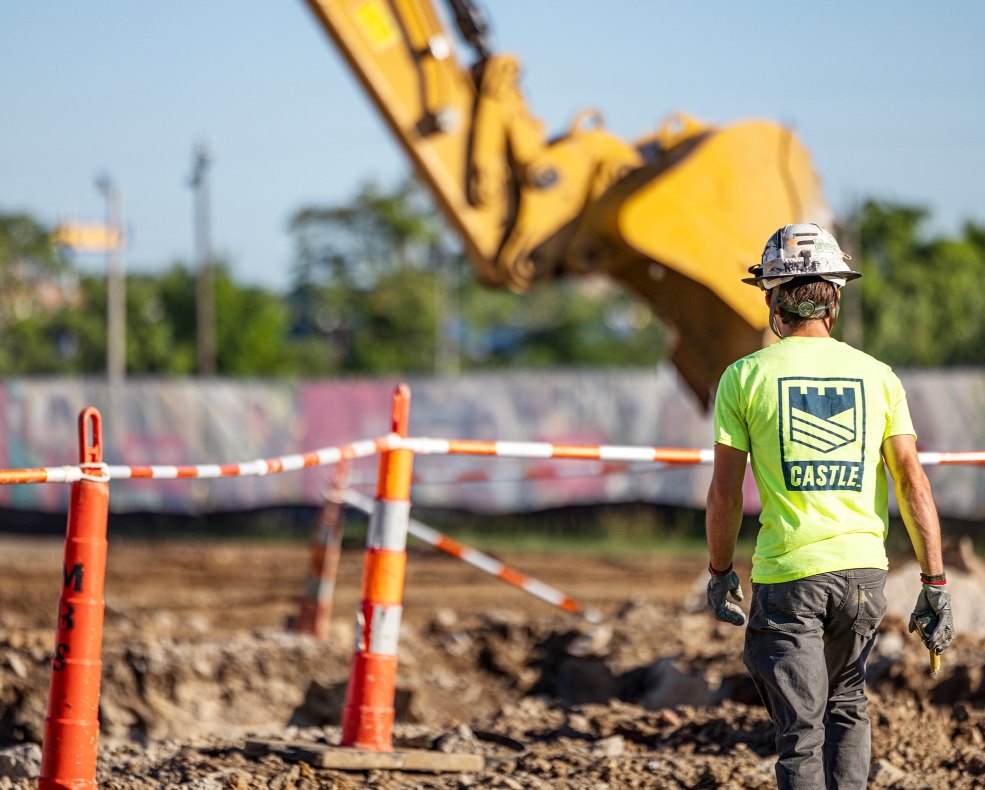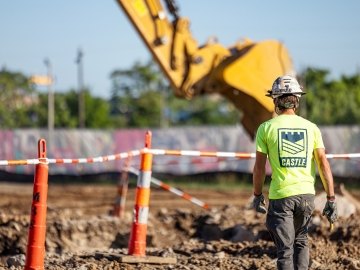Innovative Approaches Improve Project Outcomes
As the first construction crew to start working on a new jobsite, civil and sitework contractors play an important role in setting building projects up for success.


As the first construction crew to start working on a new jobsite, civil and sitework contractors play an important role in setting building projects up for success.
This work involves some of the most challenging aspects of the entire construction process: maneuvering around a spider web of buried utility lines and other potential hazards as sites are prepared for vertical construction or infrastructure upgrades.
While the core practices of civil construction have remained consistent for decades, innovative approaches to operations, technology and the gathering and utilization of data are enabling construction teams to deliver projects more accurately and efficiently than ever before.
Here are a few ways Castle is leveraging technology and other advanced tools to remain at the forefront of civil construction and deliver the schedule and cost certainty owners expect.
Smart Equipment Improves Accuracy in the Field
The tools of the trade — excavators, graders, bulldozers and other heavy equipment — are more advanced than ever. Built-in GPS navigation systems guide operators to perform their jobs more precisely, efficiently and safely. And radio-frequency identification (RFID) wireless location tracking can accurately monitor the activities of equipment on a busy jobsite in real time.
Technology also assists with equipment maintenance by providing valuable insight into fluid levels, contamination issues, and regular wear and tear. It can automatically schedule required service and proactively identify potential problems to keep equipment in good working order, so unexpected issues don’t cause downtime on the job.
Advanced Planning Increases Quality, Safety and Consistency
Prior to putting a bucket in the ground, Castle has already planned its work in detail. Our team uses Trimble GPS or Total Station survey tools to lay out all aspects of the site, including earthwork, site utilities, roads and curbs.
Using Trimble’s Business Center software, our layout expert adds drawing markups to the civil designer’s CAD drawings to create a detailed site plan. Equipment operators access this information from a rover or tablet within their cabs. The data guides them in marking the precise location of existing utilities, as well as the location where new utilities should be installed.
The Castle team also performs subsurface utility mapping to locate existing utilities on site. Mapping helps the owner understand potential risk items and cost implications related to the site early in the project planning process. It also equips the civil construction team with crucial information to plan the work sequences efficiently and safely without utility impacts once they are in the field.
Drones Help Keep Projects on Track
Castle teams use drones to regularly document the progress of site excavation work so they can assess progress and adapt the schedule as necessary. These unmanned aerial vehicles are able to efficiently survey the geo-spatial details of an entire site — everything from utility poles to sidewalks and other surface areas. Because drones can collect and report data faster than traditional methods of surveying, they help save time and overall costs.
New Delivery Methods Improve Outcomes
While each Castle client has unique project goals and measures of success, the majority of them share two common objectives: accelerating the schedule and achieving cost certainty.
With those outcomes in mind, we developed a turnkey civil design-build service for site development work. This streamlined approach combines “civil design” and “civil construction” as a single, integrated deliverable.
Despite convincing evidence that design-build is more efficient than the traditional design-bid-build delivery method, it’s still uncommon during the civil phases of construction work. Castle is helping change that mindset by achieving schedule and cost goals utilizing this delivery. Based on our experience, civil design-build projects break ground an average of 30 percent to 50 percent faster than projects completed using a traditional delivery model.
Sophisticated Tools Improve Resource Efficiency
Castle leverages a number of specialized software and business systems to optimize the efficiency of equipment and other resources. These tools are beneficial to owners in that they allow us to:
Automate manual or administrative tasks and give us more time to focus on projects
Provide more certainty on equipment availability when planning projects
Stay nimble and flexible with allocating resources since we have real-time data at our fingertips
Drive down operating costs which help us stay competitive and maximize value for owners
We use a customized Power BI dashboard, a Microsoft analytics tool, as a central digital hub for evaluating our overall productivity and efficiency. By pulling in multiple data sources, including our scheduling and dispatching system, we’re able to monitor real-time fleet telematics and ensure we have accurate data on how our equipment is being used across our projects.
Our project managers and superintendents know how to review and use this data to quickly audit the utilization and efficiency of our fleet on each jobsite. This means we know exactly where and when we can move equipment, allowing us to make faster and smarter decisions regarding equipment allocation. We also compile this historical data to help guide decision-making on future equipment purchases and rentals, enhancing operational quality on future projects for the benefit of all stakeholders.
A Foundation for Success
One of the best ways to ensure your project is set up for success is to work with a civil construction partner committed to embracing new technologies and ways of working. Castle is often the first team on the site and the work we do beneath the surface is critical to your project’s success. We solve problems, mitigate risk and engage in transparent, collaborative relationships that lead to the schedule and cost certainty our clients expect.
As Castle continues to grow and expand its geographic reach, we’ll continue embracing innovations that improve the accuracy, efficiency and value that we provide to all project stakeholders.
###
About the Author
Brian Carlson, DBIA, is a project director at Castle Contracting, with an emphasis on serving Castle’s general contractors and owner clients. He is also champion for the company’s field technology initiative and continuous improvement through the implementation of solutions that provide efficiency, enhance communication and increase client satisfaction. Brian joined Castle in 2016, helping to launch civil design-build delivery. He advocates for early collaboration and engagement of Castle’s team on all projects, leveraging technology and experience to help fill information gaps during planning as well as solve challenges to reduce risk for owners. He brings 14 years of previous experience on large scale heavy highway projects, including design-build delivery, and holds a bachelor’s in civil engineering from Missouri University of Science & Technology.

